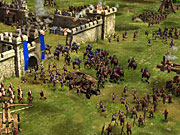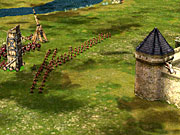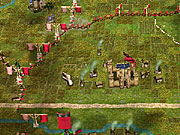Lords of the Realm III Updated Impressions
We take another look at the newest iteration of Sierra's castle-busting strategy series.
The strategy genre has been evolving lately, with more and more games combining elements of traditional real-time strategy and turn-based strategy into one package. Impressions Games, perhaps better known for its city-building games such as Caesar and Pharaoh, is attempting to make the same transformation with its Lords series. Set in the Middle Ages, the Lords of the Realm series allows you to assume the role of a medieval lord fighting for land and honor against neighboring fiefdoms. The previous iteration of Lords of the Realm was a 2D turn-based strategy with some real-time elements. Lords of the Realm III, in contrast, has a full 3D engine and is primarily a real-time game--although the battle command and kingdom management portions of the game remain as two distinct layers. The game also offers a multiplayer option over both LAN setups and the Internet.
Representatives from Sierra and Impressions recently visited GameSpot and demonstrated both the battle and kingdom management aspects of Lords of the Realm III. They also presented the castle editing tool, which will ship with the game. On the single-player side, the game comes with four campaigns covering the history of England, France, Germany, and Ireland. The missions within each campaign can involve more than two factions, and you're allowed to choose to play as any of them. Players who aren't as interested in fighting a long campaign will have a good assortment of simple battle missions from which to choose.

When you enter the battle aspect of the game, your troops are controlled at the company level. This means you will be moving and attacking with entire units of about 20 men, all led by a single knight. Unit types include the standard medieval fare, such as footmen, mounted cavalry, archers, and more. Strategy veterans will find that the pacing of battles in Lords III is relatively slow, allowing for more calculated movements rather than frantic clicking. However, this means that there will probably be fewer opportunities for players to make quick adjustments to compensate for any tactical blunders.
The game's interface allows you to change the formations of your troops to afford them different bonuses. For example, footmen can move into a special shield wall formation that gives them a defensive boost. The knights that lead your companies into battle can also be moved about to give your army different bonuses. If they command their units from the rear, your men get a boost in morale, which will keep them from fleeing or breaking ranks if the battle turns sour. You can also choose to move the knights to the front of the troops, where they serve as highly effective foot soldiers. We watched as a knight, leading a troop of archers, moved in front to intercept a nearly full-strength company of attacking footmen. Alone, he was able to distract the footmen long enough for a cavalry unit to arrive and save the archers from total destruction.

The siege units in the game are extremely diverse and include catapults, ballistae, trebuchets, and siege towers. You'll be engaging in plenty of siege battles in Lords III, so these special machines are crucial to victory. The castle defenders can make use of ballistae and catapults when mounted on the tops of towers. Boiling oil can be poured and archers can fire arrows from castle walls and battlements. Though any troop of infantry can move to a castle wall and automatically erect ladders, the siege towers are a much more efficient way to scale the castle walls. In fact, once you have a siege tower set up, it can funnel entire companies to the top of the castle walls quickly. The animation of each of the siege engines is highly articulated. As a trebuchet cocks and fires, you'll see two men cranking the firing arm into position while another couple of men heft its payload into place. As it fires, the arm comes up and slings its rocks more than a full-screen's width away.
Kingdom Management 101
The kingdom management layer of Lords of the Realm III gives you an isometric view of your lands, which are divided into regions and subdivided further into parcels. You'll assign one of four different types of vassals to each of your parcels, and each vassal gives your kingdom a different bonus. Vassals are further differentiated by name, with each having smaller, but unique, bonuses to offer. Assign a knight to a parcel, and he will erect a fortress in that area and command a certain type of troop. Serfs turn their parcels into farmland and generate food for your armies, while burghers construct cities in their parcels to generate money that can be used to hire mercenaries. The clergy vassal creates a church that makes neighboring parcels more productive and efficient. The clergy vassal also increases your Christianity rating (which plays a role in the diplomacy aspect of the game).

From the kingdom management layer you can rally individual knights and mercenaries and merge them to create larger armies. These armies are represented by a soldier who walks over the map. To attack a neighboring land you simply order your army to enter the next area. A battle commences when your army runs into an enemy army or walks into the center of a parcel (represented by a fortress, town, farm, or church). All of this is done in real time, so it is actually conceivable that you'll have two or three armies walking around and attacking other areas at once. If you stay in the kingdom management layer, the computer will handle the battles automatically, but those who want to get more "hands-on" can click on any ongoing fight and take tactical command over the battle. You'll be able to switch out of and switch over into any other battles that are simultaneously raging.
Since it can get quite time consuming and tedious to try to capture each parcel of a map individually, you'll be able to find and attack a special "estate parcel" that serves as the capital of an entire region. Capture that estate parcel, and the entire region will come under your control. If this proves too difficult you can still choose to take out individual parcels to sap strength from that region. Because they're such valuable targets, estate parcels are generally tougher to take over than regular parcels. Knights who set up shop there will erect a full castle instead of a smaller fortress. If you put a clergyman there, you'll get a large cathedral and not a church; this cathedral will offer much bigger bonuses to your entire kingdom rather than to just the surrounding region. Similarly, the other two vassals' creations provide boosts if you place them in an estate parcel.

Lords of the Realm III's castle editor lets you create a custom-designed castle for use in the game. You can easily construct walls of varying heights and thicknesses. You can also erect drawbridge entrances, towers, static defenses, buttresses, keeps, and more. You can even surround your castle with a moat. Depending on how elaborate and protective you make your castle, the game assigns to it a monetary and time-to-create cost. So if you decide you want to pull out all the stops in your architecture, you'll have to weigh that desire against its practicality in the game.
Overall, Lords of the Realm III is coming along nicely and looks as though it will have plenty to offer to strategy game fans--particularly those who enjoy medieval-era games. For the most part, the game seems fairly complete. Though a good part of the castle siege animations remain incomplete, and there are a couple of niggling bugs in the castle editor, all the interfaces and artwork are ready. Lords of the Realm III is currently scheduled to be released in late 2003.
Got a news tip or want to contact us directly? Email news@gamespot.com
Join the conversation